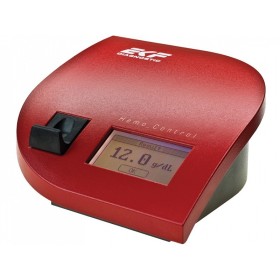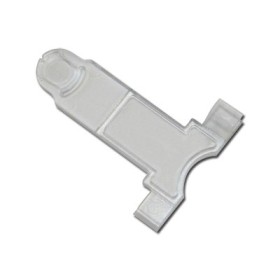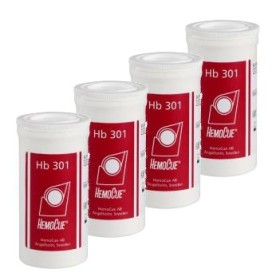Pagamenti sicuri
con carta di credito, Paypal e bonifico bancario.
con carta di credito, Paypal e bonifico bancario.
Spedizioni rapide
con corrieri BRT, DPD e FedEx
con corrieri BRT, DPD e FedEx
Assistenza Clienti
via Whatsapp +39.371.43.61.201
via Whatsapp +39.371.43.61.201
Descrizione
Il fotometro HemoCue su sangue intero fornisce valore di emoglobina in maniera veloce, semplice e accurata, con le stesse prestazioni di un grosso analizzatore ematico.
I fotometri a doppia lunghezza d'onda tengono conto di lipemia, leucocitosi e altre fonti di torbidità.
Può essere utilizzata qualsiasi tipologia di sangue (capillare, venoso o arterioso).
Le affidabili cuvettes raccolgono l'esatta quantità di sangue e diluiscono automaticamente il campione con i reagenti.
Il risultato compare sul display in meno di un minuto.
Caratteristiche Tecniche:
Measurement Range: 0—25.6 g/dL (0—256 g/L or 0—15.9 mmol/L)
Accuracy: Correlation of 0.99 when compared to the reference method (ICSH method). The accuracy of the system has proven to be ±1.5%.
Results: The analyzers display the results within 60 seconds.
Sample Volume: 10 µL
Sample Material: Capillary, venous or arterial blood.
Calibration: The analyzers are calibrated at the factory against the ICSH reference method.
Principle: The reaction in the cuvette is a modified azidemethemoglobin reaction. The erythrocyte membranes are disintegrated by sodium deoxycholate, releasing the hemoglobin. Sodium nitrite converts the hemoglobin iron from the ferrous to the ferric state to form methemoglobin, which then combines with azide to form azidmethemoglobin. The analyzer uses a double wavelength measuring method, 570 nm and 880 nm, for compensation of turbidity.
Method: Vanzetti, G. An azidemethemoglobin method for hemoglobin determination in blood. J. Lab. Clin. Med. 67, 116-26 (1966).
Dimensions:
Hb 201+: 3.35 x 6.3 x 1.69 inches (85 x 160 x 43 mm)
Hb 201 DM: 3.66 x 6.79 x 1.97 inches (93 x 170 x 50 mm)
Weight:
Hb 201+: 0.77 pounds (0.35 kg)
Hb 201 DM: 0.77 pounds (0.35 kg)
Power: Drawn from HemoCue AC Adapter or internal batteries.
Storage and Environmental Requirements:
Microcuvette:
The microcuvettes are to be stored at 59-86° F (15-–30° C) in a dry place. Once opened the microcuvettes are stable for three months. The container lid should always be kept closed.
Analyzer:
The analyzers can be stored at 32-122° F (0-50° C).
The operating temperature is 59-86 °F (15-30 °C).
Prior to use, allow the analyzer to reach ambient temperature before use.
I fotometri a doppia lunghezza d'onda tengono conto di lipemia, leucocitosi e altre fonti di torbidità.
Può essere utilizzata qualsiasi tipologia di sangue (capillare, venoso o arterioso).
Le affidabili cuvettes raccolgono l'esatta quantità di sangue e diluiscono automaticamente il campione con i reagenti.
Il risultato compare sul display in meno di un minuto.
Caratteristiche Tecniche:
Measurement Range: 0—25.6 g/dL (0—256 g/L or 0—15.9 mmol/L)
Accuracy: Correlation of 0.99 when compared to the reference method (ICSH method). The accuracy of the system has proven to be ±1.5%.
Results: The analyzers display the results within 60 seconds.
Sample Volume: 10 µL
Sample Material: Capillary, venous or arterial blood.
Calibration: The analyzers are calibrated at the factory against the ICSH reference method.
Principle: The reaction in the cuvette is a modified azidemethemoglobin reaction. The erythrocyte membranes are disintegrated by sodium deoxycholate, releasing the hemoglobin. Sodium nitrite converts the hemoglobin iron from the ferrous to the ferric state to form methemoglobin, which then combines with azide to form azidmethemoglobin. The analyzer uses a double wavelength measuring method, 570 nm and 880 nm, for compensation of turbidity.
Method: Vanzetti, G. An azidemethemoglobin method for hemoglobin determination in blood. J. Lab. Clin. Med. 67, 116-26 (1966).
Dimensions:
Hb 201+: 3.35 x 6.3 x 1.69 inches (85 x 160 x 43 mm)
Hb 201 DM: 3.66 x 6.79 x 1.97 inches (93 x 170 x 50 mm)
Weight:
Hb 201+: 0.77 pounds (0.35 kg)
Hb 201 DM: 0.77 pounds (0.35 kg)
Power: Drawn from HemoCue AC Adapter or internal batteries.
Storage and Environmental Requirements:
Microcuvette:
The microcuvettes are to be stored at 59-86° F (15-–30° C) in a dry place. Once opened the microcuvettes are stable for three months. The container lid should always be kept closed.
Analyzer:
The analyzers can be stored at 32-122° F (0-50° C).
The operating temperature is 59-86 °F (15-30 °C).
Prior to use, allow the analyzer to reach ambient temperature before use.
Scheda tecnica
6 altri prodotti della stessa categoria:











